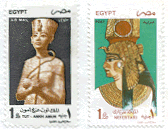World-view
Children learn two broad categories of
things during the socialization process. First, there are the common practices and
institutions of a culture, including its language, style of dress, what is
considered edible, the expected roles of mothers, fathers, teachers,
etc. These things are relatively easy to observe by anthropologists and
other outsiders visiting from a different society. The second thing acquired during socialization
is a world-view. This is the complex of motivations, perceptions,
and beliefs that we internalize and that strongly affect how we interact with
other people and things in nature.
World-views are rarely verbalized by people, but they can be inferred by their actions. For instance, if you believe that most people are honest and will not cheat you, it is likely that you will be open and trusting of others. Most people are unable to describe their world-view beliefs because they remain in their mind as rather fuzzy assumptions about people, society, and existence in general. World-view is a set of feelings and basic attitudes about the world rather than clearly formulated opinions about it. These feelings and attitudes are mostly learned early in life and are not readily changed later.
In small-scale societies, most people share essentially the same world-view because they are socialized in much the same way. In complex large-scale societies, however, there often is a large amount of variation in world-views. This is due to the fact that these societies often are culturally heterogeneous and have major differences in socialization practices.
Types of World-views
Much of the pioneer research into the nature of world-views was done in the early 1950's by Robert Redfield. He concluded that world-views in all societies make some of the same kinds of basic distinctions in categorizing and relating to things in the world and the cosmos. He said that world-views distinguish humans from everything that is "not human." The "not human" is in turn subdivided into the realms of nature and the supernatural (i.e., everything that is beyond nature). World-views differ in how these three realms are believed to be related. Most crucially, they differ in how they see humans in relationship to nature and the supernatural.
 |
realms of existence to which world views relate in one way or another |
These differences in how people relate to nature
and the supernatural led Redfield to conclude that there are two
principal kinds of world-views. He referred to them as "mythological"
![]() and "civilized." Today, they are more often referred to as "indigenous"
and "civilized." Today, they are more often referred to as "indigenous"
![]() and
"metropolitan"
and
"metropolitan"
![]() .
.
Those who have an indigenous world-view believe that humans are not separate from nature and the supernatural. Living creatures and non-living objects in nature as well as supernatural beings are thought to be human-like in their motivations, feelings, and interactions. They all are perceived as "thous" rather than "its." Animals, trees, rocks, spirits, and gods all possess human characteristics and can be involved with humans and their everyday concerns much the same way as other people. Even "inanimate" things in nature, such as rocks, are thought to potentially have human-like personalities. In other words, there is not a separation of people, nature, and the spirit world. Rather, there is an emotional involvement between them. Things in all three of these realms of existence can interact together just as humans do with each other. Indigenous world-views are common in small-scale relatively isolated societies such as those of foragers, pastoralists, and horticulturalists.
|
|
|
|
Spanish ritual of human |
|
Those who have a metropolitan world-view maintain an emotional detachment between people and the realms of nature and the supernatural. Animals, trees, rocks and other things in nature are thought to be inanimate--they are "its" rather than "thous" and do not have human personalities. This separation of humanity emotionally from nature allows people to exploit it with little care for its well being. For instance, the course of a river may be changed or a hill leveled by bulldozers without being concerned about whether the "spirit" in these natural objects will be angered. The ruthless exploitation of nature is seen as something very different from interacting with people. In the Western World dominated by the metropolitan world-view, humans are the only beings believed to have souls. Subsequently, the crime of murder only applies to the killing of people.
Metropolitan world-views also generally distance humans
from the supernatural world. The gods live apart from people. They
do not interact with us in a direct human way. It is not in the realm of
possibilities that a god will come to earth, participate as a warrior in a
battle or marry a human. Gods are generally seen as otiose deities
![]() .
That is to say, they established the order of the universe in the distant past and are now remote
from earthly activities and concerns.
.
That is to say, they established the order of the universe in the distant past and are now remote
from earthly activities and concerns.
Redfield's distinction between indigenous and metropolitan world-views is insightful and serves as a starting point for understanding what world-views are all about. However, world-views are involved in more than just the orientation of humans to nature and the supernatural. They also are concerned with core values. These are the fundamental values that provide the basis for social behavior in society. They are what people believe is desirable or offensive, appropriate or inappropriate, and correct or incorrect. Core values entail such things as a belief in the rightness of "one man, one vote" in political decision making or the conviction that we should live in harmony with nature rather than try to dominate it. They also include beliefs that may be more nebulous, such as the feeling that all people are basically good or that evil deeds will always be punished eventually. Core values can vary markedly from culture to culture.
What Are Your World-view
Beliefs?
It may not be easy for you to say what your personal world-view beliefs are because you probably have not critically evaluated them. One way of doing that is to think about opposing beliefs and consider which way you come out on the issues. In order to begin this process of self-evaluation, think about the following polar opposite positions and decide which ones you feel most comfortable with. This will give you some insight into your own core values and world-view.
| 1. | Do you believe that things are interrelated
in complex ways and that
there are degrees of difference? In contrast, do you see things in
terms of sharp distinctions? To put it another way, are issues
usually black and white for you or do you see them as having gray areas?
For example, is lying to a friend always wrong? Are some lies less
bad because they are intended to prevent your friend from feeling bad
about something or being disillusioned? |
|||
| 2. | Do you prefer things to be unchanging and stable?
Do you like to do things the same traditional way every time? In
contrast, do you prefer to do things in new ways, and do you enjoy having
a changing and unpredictable life? For example, when you go out to
dinner, do you like to go to the same restaurant every time and order
the same sort of food or do you like to take a risk and try new
restaurants and foods that are unknown to you? |
|||
| 3. |
Do you like to take unnecessary personal
physical risks or are
you content with the safe path through life? For
example, do you enjoy rock climbing, surfing big waves, or
other sports that inherently involve a high risk for your safety?
Do you get bored when you are not looking forward to such risky
activities? When mentally calculating the risk potential of an
activity, you probably compare it subconsciously to your own personal internal anxiety-security
scale. High risk activities move you in the direction of anxiety.
Low risk ones move you toward security. At which end of this scale
are you the happiest? Does security mean boredom for you or
comfort? |
|||
| 4. | Do you prefer competition or cooperation? For example, do you like games in which there are clear winners and losers or would you rather spend your time in non-competitive activities in which winning is not a goal? It is worth noting that businesses in the Western World run on the basis of competition with each other. The winners make more money and the losers go broke. Likewise, most of our sports are highly competitive. Baseball, football, soccer, and track events are designed to result in winners and losers. Are you comfortable with this? |
World-view and the Perception of Time
One aspect of world-views that has an important impact on the way we live our lives and interact with each other is how we perceive and use time. Most people in the Western World today think of time as being fixed in nature. It is seen as something from which we cannot escape. Time for us has segments or compartments which are discrete and constant in duration. These time segments (seconds, minutes, hours, etc.) are arbitrary creations. They are not natural divisions in nature. We fix time slots for activities and usually work on them only within the bounds of these slots. When the time slot is over, we usually quit what we are doing, finished or not. Most office and factory workers work for a predetermined number of hours and minutes. When the time is up, they usually quit working and go home, whether their assigned task is completed or not. In contrast, people in some traditional Arab societies view the activity as being more important than the time period. They start at one point in time and go on until they are finished or interrupted.
 |
 |
|
|
Do you think
that these North American office workers will |
||
|
|
|
|
Common Egyptian
postage
stamps |
World-views also involve a focus on the past, present, or future. Most North Americans are strongly oriented toward the future. This is especially true of young adults. Their focus is usually the immediate foreseeable future of a few years. Most college students are willing to work toward degrees even though it often means that they must delay establishing a career, getting married, and having a family. They do this because they expect a future payoff. That future is most often viewed as being only a few years away. In contrast, the Chinese traditionally have focused on several generations in the future. As a result, people often work hard, sacrificing their lives, so that their family will be wealthy in their children's or grandchildren's generation. It will be interesting to see if this pattern of long term goal oriented sacrifice persists as China continues to rapidly embrace Western cultural influences.
World-view orientations can also involve looking to the past as a more glorious utopian era. In Egypt, most of the postage stamps have images of ancient Egyptian rulers, buildings, and other artifacts from antiquity. This serves as a national reminder of the "great times" of Egypt in the past. Likewise, when former President Ronald Reagan talked about the importance of family values, he often referred to the time in America when he was growing up. The 1920's and 1930's were in a way a golden age for him.
This page was last updated on
Tuesday, December 19, 2006.
Copyright © 2002-2006 by Dennis
O'Neil.
All rights reserved.
Illustration credits

